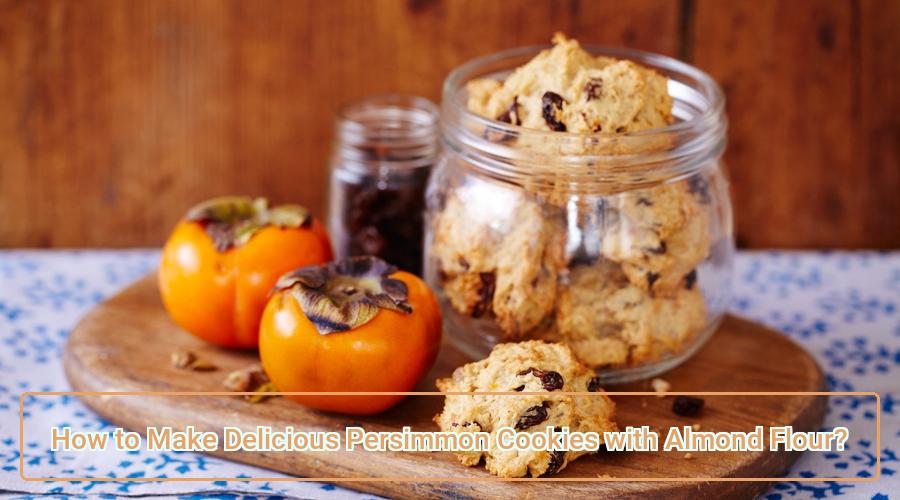In this blog post, we will be sharing a step-by-step guide on how to make these delicious persimmon cookies. We will also be discussing the health benefits of persimmons and almond flour, as well as some tips for baking with almond flour. Whether you are a seasoned baker or a beginner, this recipe is easy to follow and perfect for anyone looking to incorporate healthier ingredients into their baking.
So grab your apron and let’s get baking these delicious persimmon cookies with almond flour. Your taste buds and your body will thank you!

Benefits of Using Almond Flour in Persimmon Cookies
Almond flour is a healthy and versatile alternative to wheat flour in baking, and it works exceptionally well in persimmon cookies. Not only is it gluten-free, but it’s also low in carbs and high in protein and healthy fats, making it a perfect choice for those who are health-conscious or have dietary restrictions. Using almond flour in persimmon cookies also imparts a nutty flavor and a moist texture to the cookies, making them even more delicious and nutritious.
Another benefit of using almond flour in persimmon cookies is that it has a lower glycemic index than wheat flour, which means it doesn’t spike your blood sugar levels as much. This is especially important for those who are diabetic or watching their sugar intake. Almond flour also contains more fiber than wheat flour, which promotes satiety and keeps you feeling fuller for longer. This can help prevent overeating and aid in weight management.
Using almond flour in persimmon cookies is a great way to incorporate more nutrients into your diet. Almond flour is a good source of vitamin E, magnesium, and other minerals that are important for maintaining optimal health. It also contains antioxidants that help protect your cells from damage caused by free radicals. Adding almond flour to persimmon cookies is a simple and delicious way to boost your nutrient intake and support your overall health and well-being.
A Beginner’s Guide to Baking with Almond Flour
Baking with almond flour has become increasingly popular in recent years, thanks to its many health benefits and versatility in recipes. Almond flour is a type of flour made from finely ground blanched almonds, and it’s a great alternative to wheat flour for those who are gluten-free or looking for a healthier option. If you’re new to baking with almond flour, this beginner’s guide will help you get started.
When baking with almond flour, it’s important to remember that it doesn’t behave exactly like wheat flour. Almond flour is much denser and has a higher fat content, which means that baked goods made with it tend to be more moist and have a slightly nutty flavor. It’s also important to note that because of its high fat content, almond flour can go rancid fairly quickly, so it’s best to store it in an airtight container in the refrigerator or freezer.
One of the benefits of using almond flour in your baking is its nutritional value. Almond flour is high in protein, fiber, healthy fats, and various vitamins and minerals, making it a great way to add some extra nutrition to your baked goods. It also has a low glycemic index, which means that it doesn’t cause a rapid spike in blood sugar levels like wheat flour can. Overall, baking with almond flour is a great way to make your favorite treats a little healthier without sacrificing taste or texture.

Why You Should Try Making Persimmon Cookies with Almond Flour?
If you’re a fan of persimmon cookies, then you should definitely try making them with almond flour. Almond flour is a great substitute for regular flour because it is gluten-free and low in carbohydrates, making it a healthier option. It’s also a great source of protein, healthy fats, and other nutrients that can help you stay full and satisfied.
Using almond flour in your persimmon cookies can also make them more flavorful and moist. Almond flour has a nutty flavor that pairs well with the sweetness of the persimmons, and it also adds a unique texture to the cookies. Plus, the added moisture from the almond flour can help keep your cookies from becoming too dry or crumbly.
Another great reason to try making persimmon cookies with almond flour is that they are easy to make. With just a few simple ingredients and a little bit of time, you can have delicious and healthy cookies that you can enjoy anytime. Plus, because almond flour is so versatile, you can use it in a variety of other recipes, including cakes, muffins, and more. So why not give it a try and see for yourself how delicious and nutritious persimmon cookies with almond flour can be?
Persimmon Cookies with Almond Flour: Ingredients You’ll Need
If you’re looking for a gluten-free and healthy snack, persimmon cookies with almond flour are a great option to consider. These cookies are easy to make, and they’re packed with nutrients. Here are the ingredients you’ll need to make them:
- Almond flour: Almond flour is a great gluten-free substitute for wheat flour. It’s made from ground almonds and has a slightly sweet and nutty flavor that works well with the other ingredients in these cookies.
- Persimmons: You’ll need ripe persimmons to make these cookies. Persimmons are a great source of fiber, vitamins A and C, and other nutrients. They also add a natural sweetness to the cookies.
- Coconut oil: Coconut oil is a healthier alternative to butter or margarine. It’s high in medium-chain triglycerides, which are a type of healthy fat that can improve cholesterol levels and boost brain function.
- Maple syrup: Maple syrup is a natural sweetener that adds a delicious flavor to the cookies. You can use other sweeteners like honey or agave nectar, but maple syrup works particularly well with the other ingredients in this recipe.
- Spices: You can add a variety of spices to these cookies to give them more flavor. Cinnamon, nutmeg, and ginger all work well, but you can experiment with other spices to find the combination you like best.

Vegan and Gluten-Free Persimmon Cookies with Almond Flour
To make vegan and gluten-free persimmon cookies with almond flour, you’ll need a few simple ingredients, including ripe persimmons, almond flour, coconut oil, and maple syrup. The ripe persimmons give the cookies a sweet and fruity taste, while the almond flour gives them a nutty flavor and a tender, crumbly texture. You can also add spices like cinnamon and nutmeg to give the cookies a warm and comforting taste.
To start, preheat your oven to 350°F and line a baking sheet with parchment paper. In a mixing bowl, combine the almond flour, baking soda, and spices. In another bowl, mash the ripe persimmons and add in the coconut oil and maple syrup. Mix the dry and wet ingredients until well combined, then spoon the dough onto the baking sheet and flatten them slightly with a fork. Bake the cookies for 15-20 minutes until golden brown, then let them cool on a wire rack before serving.
Overall, vegan and gluten-free persimmon cookies with almond flour are a delicious and healthy treat that everyone can enjoy. They are perfect for satisfying your sweet tooth while providing valuable nutrients and antioxidants from the fresh fruits and almond flour. Give this recipe a try and enjoy a guilt-free snack anytime!
Tips for Perfectly Baked Persimmon Cookies with Almond Flour
First and foremost, it’s important to use the right type of almond flour. You’ll want to use blanched almond flour, which is made from blanched almonds that have had their skins removed. This type of almond flour is finer and lighter than other varieties, which makes it ideal for baking.
Next, it’s important to use the right amount of almond flour in your recipe. Too little flour and your cookies will be too moist and fall apart easily, while too much flour will make your cookies dry and crumbly. It’s best to measure your flour by weight rather than volume to ensure that you’re using the correct amount.
Finally, make sure to watch your cookies closely while they’re baking. Almond flour can burn easily, so it’s important to keep a close eye on your cookies as they bake. You’ll want to remove them from the oven as soon as they’re lightly golden brown around the edges. Let them cool on the baking sheet for a few minutes before transferring them to a wire rack to cool completely.
How to Store Persimmon Cookies with Almond Flour?
First, allow the cookies to cool completely before storing them. If they are still warm, they will release moisture and become soggy. Once cooled, place the cookies in an airtight container. You can use a plastic container with a tight-fitting lid, a cookie jar, or a ziplock bag.
When storing the cookies, make sure to layer them with parchment paper to prevent them from sticking together. If the cookies are stacked on top of each other without any barrier, they might get squished, and the icing or toppings can smear.
Persimmon cookies with almond flour can be stored at room temperature for up to three days. If you plan to keep them for more than three days, it’s best to store them in the refrigerator. They can last up to a week in the refrigerator. When you’re ready to enjoy them, take the cookies out of the fridge and let them come to room temperature before eating.

Different Variations of Persimmon Cookies: Almond Flour and Beyond
One popular variation of persimmon cookies with almond flour is to add spices such as cinnamon, nutmeg, or ginger to the dough. These spices not only add a warm and cozy flavor to the cookies but also provide health benefits such as anti-inflammatory properties and improved digestion. Additionally, you can mix in chopped nuts, dried fruit, or chocolate chips for added texture and sweetness.
For those following a vegan or dairy-free diet, there are variations of persimmon cookies that use plant-based substitutes for butter and eggs. Coconut oil or applesauce can be used instead of butter, while chia seeds or flaxseed meal can be used as an egg substitute. These variations can result in cookies that are just as delicious and satisfying as the classic recipe.
In addition to almond flour, there are other alternative flours that can be used in persimmon cookies, such as oat flour, coconut flour, or quinoa flour. Each type of flour has its own unique texture and taste, and experimenting with different flours can result in a cookie that suits your personal preferences. With so many options to choose from, persimmon cookies with almond flour are just the beginning of the many delicious and healthy variations of this beloved treat.
Common Mistakes to Avoid When Baking Persimmon Cookies with Almond Flour
Firstly, avoid over-mixing the dough. Almond flour can be delicate and over-mixing can cause it to become too sticky and hard to work with. To avoid this, mix the ingredients just until the dough comes together. Also, don’t forget to chill the dough in the refrigerator for at least 30 minutes before baking. This will help the cookies hold their shape and prevent them from spreading too much in the oven.
Another mistake to avoid is not measuring the ingredients properly. Almond flour is heavier than all-purpose flour, so using the correct measurement is crucial for the success of your recipe. Using too much almond flour will make the dough too dry, while using too little will make it too sticky. To avoid this, use a kitchen scale to weigh the flour, or use the spoon and level method when measuring the flour.
Lastly, avoid baking the cookies at a temperature that’s too high. Almond flour can brown quickly and burn easily, so it’s important to bake the cookies at a lower temperature, around 325°F. This will ensure the cookies are fully cooked but not too brown on the outside. Also, be sure to keep an eye on the cookies towards the end of the baking time to ensure they don’t overcook or burn.
Can I substitute almond flour with other types of flour for persimmon cookies?
While it is possible to use other types of flour for persimmon cookies, almond flour is preferred for its nutty flavor and moist texture. If you want to substitute almond flour, you may need to adjust the amount of liquid and other ingredients in the recipe. It’s best to use a recipe specifically designed for the type of flour you want to use.
Are persimmon cookies with almond flour healthy?
Persimmon cookies with almond flour can be a healthier alternative to traditional cookies, as almond flour is low in carbohydrates and high in protein and healthy fats. Persimmons are also a good source of vitamins, minerals, and antioxidants. However, the addition of sweeteners and fats can still make these cookies high in calories, so it’s important to consume them in moderation as part of a balanced diet.
How do I know if persimmons are ripe enough to use for cookies?
Persimmons are ripe and ready to use for cookies when they are soft and fully orange in color. Unripe persimmons can be quite bitter and astringent, while overripe persimmons can be too soft and mushy. If you are not sure whether your persimmons are ripe, you can press the skin lightly with your fingers – it should yield slightly without feeling too mushy. You can also cut one open to check its color and texture.




